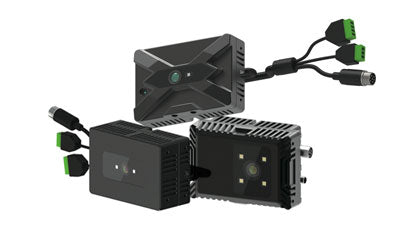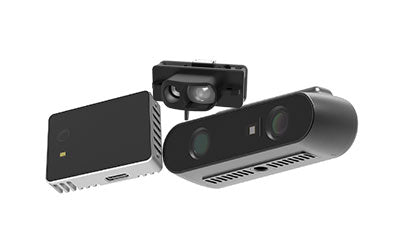ToF Gesture Control for Smart Appliances: Touchless Home Made Easy

How Can ToF Technology Enable Touchless Gesture Control in Smart Appliances?
I. Background: The Rise of Contactless Interaction in the Smart Appliance Era
With the rapid development of artificial intelligence (AI), the Internet of Things (IoT), and sensor technologies, the global home appliance industry is undergoing a new revolution in human–machine interaction. Over the past decade, appliances have evolved from mechanical buttons to voice recognition, and now further into the realm of contactless gesture control. Modern users expect to interact with their devices through natural, intuitive, and touch-free gestures, rather than relying solely on remote controls or voice commands.
In the post-pandemic era, the emphasis on hygiene and health has greatly increased, driving the popularity of touchless interaction technologies in the smart home sector. Whether waving a hand to switch oven modes while cooking, adjusting bedroom lighting with a simple motion, or controlling TV volume with a gesture in the living room, contactless operation is rapidly becoming a standard feature of modern smart appliances.
At the heart of this transformation lies TOF (Time-of-Flight) technology. By measuring the time it takes for light to travel to and from a target, ToF sensors can quickly generate high-precision 3D depth maps. Compared with traditional infrared or ultrasonic sensors, ToF offers greater distance accuracy, faster response time, and stronger resistance to environmental interference. This enables appliances to detect even the slightest hand movements in milliseconds, accurately capturing gestures and spatial positions for precise, stable, and low-latency control.
Moreover, ToF technology can do more than recognize simple gestures like swiping or tapping—it can also work with AI algorithms to interpret user intent and behavioral patterns. For example, when a user approaches a TV, the screen can automatically light up; when a hand movement is detected, the system can change channels or adjust the volume. This intelligent perception-based interaction transforms appliances from passive responders into proactive, context-aware assistants that understand and adapt to the user’s needs.
What Is the Time-of-Flight (ToF) Sensor?
A ToF sensor TOF (Time-of-Flight) measures the time it takes for light to travel from the emitter to an object and back, thereby calculating distance and generating 3D depth information.
Compared to conventional cameras, ToF sensors can capture real-time 3D spatial data with high accuracy, fast response, and strong resistance to interference. They are widely used in smart warehouse robots for obstacle avoidance, smartphone facial recognition, autonomous driving, and industrial inspection applications.
II. The Core Role of ToF in Gesture Recognition and Intelligent Interaction
1. High-Precision Gesture Recognition
In the field of contactless control for smart appliances, ToF (Time-of-Flight) depth sensing has become the key technology for achieving high-precision gesture recognition. By emitting modulated light signals and measuring their return time, a ToF camera can generate millisecond-level 3D depth maps of a user’s hands and body. Compared with traditional 2D image-based recognition, ToF provides richer spatial information, allowing the system to accurately capture gesture position, direction, speed, and shape.
Powered by AI vision algorithms and deep learning models, smart appliances can analyze ToF depth data to interpret user intent and recognize various dynamic gestures, such as:
-
Waving to turn on/off TVs, curtains, or lighting systems;
-
Lifting the hand to increase air conditioner temperature or fan speed;
-
Rotating fingers to adjust volume, cooking intensity, or fan levels;
-
Opening or closing the palm to start or pause washing machines or humidifiers.
This fusion of 3D depth sensing and AI-based recognition dramatically enhances the naturalness and reliability of human–machine interaction. Unlike traditional camera-based systems, ToF maintains high recognition accuracy even under low light, strong light, or visually complex backgrounds. Whether in a kitchen with steam and oil, a humid bathroom, or a dimly lit room, ToF ensures accurate and stable gesture recognition.
Beyond convenience, ToF gesture recognition also solves practical challenges such as dirty, wet, or occupied hands. Users can control appliances without touching surfaces, reducing the spread of bacteria and improving hygiene. This aligns with modern consumers’ demand for cleanliness, safety, and intelligent convenience.
In the future, as ToF modules integrate more tightly with AI chips, gesture recognition will achieve greater accuracy, faster response, and more complex multi-finger tracking. Appliances will evolve from executing simple commands to understanding user preferences and predicting intent—delivering a truly intuitive and personalized smart living experience.
2. Motion Control and Real-Time Response
Through the integration of high-performance ToF sensors and AI-powered deep learning algorithms, smart appliances can achieve millisecond-level gesture detection, depth calculation, and command execution, enabling true real-time responsiveness. Whether in the kitchen, bathroom, or bedroom, users can control appliances effortlessly without physical contact, enhancing both convenience and safety.
Examples include:
-
Kitchen: When hands are covered in oil or ingredients, users can wave to start the oven, adjust the range hood speed, or activate the microwave.
-
Bathroom: While washing hands or showering, gestures can control mirror lighting, exhaust fans, or heater settings.
-
Living room: A simple hand wave can switch TV channels, change music tracks, or adjust lighting color and brightness.
This contactless control minimizes physical touch, reducing bacterial transmission and water damage risks. ToF systems can also interpret motion trajectories—such as gesture hold duration or swipe speed—to dynamically adjust responses, ensuring smooth and natural control.
Furthermore, by combining multi-frame depth data and real-time filtering, ToF-based systems maintain high recognition accuracy in multi-user environments, preventing false triggers or latency. Even when several people are present, the system can correctly identify and respond to individual gestures, enabling seamless, multi-user smart interaction across the home.
3. Personalized User Interaction
By combining ToF gesture recognition, AI deep learning algorithms, and spatial positioning technology, smart home appliances can deliver personalized user interactions — automatically adapting responses based on different users’ habits, preferences, and identity information.
Specific applications include:
-
Personalized Environment Settings:
Once the system recognizes a specific family member, it can automatically adjust the air conditioner temperature, lighting brightness, curtain angle, or music mode — providing a tailored and comfortable experience. -
Behavioral Habit Learning:
The AI algorithm analyzes users’ habitual gestures — for example, if a user often waves to turn on the lights, the system can optimize gesture recognition logic accordingly, reducing false detections and redundant actions. -
Multi-User Switching & Permission Management:
In shared or family spaces, the ToF + AI system can distinguish between different users’ gestures, enabling personalized responses while ensuring security and privacy for other users. -
Intelligent Scene Automation:
When a user enters a room, the ToF system can detect their position and movement state to trigger smart scene modes automatically — for instance, “movie mode” can dim the lights, close the curtains, and start the projector and sound system.
This personalized smart interaction makes home appliances more intuitive and user-centered, enhancing the overall intelligence level of the home environment. Users no longer need to manually adjust settings — the system automatically optimizes operations based on context, time, location, and personal preferences, allowing AI gesture recognition technology to reach its full potential in smart home scenarios.
In the future, as ToF sensor resolution and AI algorithm capabilities continue to advance, smart appliances will be able to recognize more complex multi-gesture combinations, body postures, and even user intent, enabling truly proactive, full-home, touch-free control.
3. Technical Challenges: How to Improve the Reliability of ToF Gesture Control
Although ToF (Time-of-Flight) technology demonstrates great advantages in gesture recognition and motion control for smart appliances, it still faces several technical challenges in real-world applications. Improving reliability and user experience requires optimization across hardware, algorithms, and system integration.
1. Recognition Accuracy and Complex Motion Capture
In environments with complicated lighting or strong background interference, ToF cameras may capture depth images with noise, blurred edges, or multipath reflections — reducing gesture recognition accuracy. Rapid motions like fast waving, rotation, or multi-finger gestures can also be difficult to interpret precisely.
To solve these issues, the industry often applies multi-frame depth data fusion to combine consecutive frame data and eliminate random noise. In parallel, AI deep learning models are trained to recognize complex gesture patterns, improving adaptability to subtle movements and multi-user scenarios. Additionally, spatial filtering and motion prediction algorithms can anticipate user actions, reducing false detections and enhancing interaction stability.
2. Response Speed and System Latency
High-resolution ToF cameras generate large volumes of depth data. If the processor performance or algorithm efficiency is insufficient, system latency can occur, degrading the user experience. In environments like kitchens or bathrooms, even millisecond-level delays can lead to failed or unintended gestures.
To enhance responsiveness, embedded AI chips or edge computing platforms can process data locally, converting depth information into commands in real time. FPGA/GPU parallel acceleration and lightweight deep learning models can also significantly improve processing performance, enabling millisecond-level response and ensuring smooth, safe operation.
3. Light Interference and Environmental Adaptability
Lighting conditions are one of the biggest challenges for ToF gesture recognition. Strong light, reflective surfaces, or transparent objects may disrupt optical signals and distort depth information. Scenarios such as sunlight through windows, mirrors in bathrooms, or metallic kitchen counters can increase false detections.
Solutions include:
-
Multi-Frequency Modulation: Reduces multipath interference by emitting light pulses at different frequencies.
-
Ambient Light Suppression Algorithms: Dynamically filter background light, ensuring stability in bright or mixed lighting conditions.
-
Automatic Exposure and Gain Control: Adjusts ToF camera parameters in real time according to ambient brightness, maintaining accurate gesture capture in both day and night environments.
Through these optimizations, ToF-based gesture control systems can maintain high precision, fast responsiveness, and low false detection rates even under complex conditions — ensuring a seamless, hygienic, and intuitive touchless control experience across all smart home environments.
4. Recommendations for Appliance Manufacturers: How to Enhance Products with ToF Technology
-
Integrate AI Algorithms with ToF Sensing Modules
Combine ToF sensors with deep learning models to support dynamic gesture recognition, motion prediction, and intent understanding for more natural human–machine interaction. -
Optimize Hardware Design to Reduce Cost and Power Consumption
Use integrated ToF modules (VCSEL + SPAD architecture) to improve measurement accuracy and reduce power usage — an ideal low-cost, high-performance solution for compact appliances. -
Support IoT Connectivity and Smart Linking
Connect via Wi-Fi, Bluetooth, or Matter protocols to integrate ToF + AI + IoT functions. Users can control entire home systems — lights, air conditioning, audio, and security — with gestures. -
Enhance Scenario-Based Design and UX Experience
Optimize detection angles and distance ranges for specific environments (kitchen, living room, bathroom, bedroom) and align gesture logic with user habits to create appliances that truly 'understand people.'
5. Future Outlook: ToF + AI + IoT Shaping a Fully Touchless Smart Home Ecosystem
In the near future, smart homes will adopt ToF as a core technology, integrating AI computing and IoT connectivity to build a comprehensive touch-free control system:
-
ToF + AI: Enables deep learning–driven gesture recognition and motion prediction.
-
ToF + IoT: Supports cross-device coordination for immersive, multi-scenario automation.
-
ToF + 5G/Edge Computing: Provides ultra-low latency, high-speed transmission, and edge intelligence.
When users step into their homes, a simple gesture will control lighting, music, temperature, and security — delivering a truly 'human-centered' intelligent living experience.
Synexens 3D Camera Of ToF Sensor Soild-State Lidar_CS20
After-sales Support:
Our professional technical team specializing in 3D camera ranging is ready to assist you at any time. Whether you encounter any issues with your TOF camera after purchase or need clarification on TOF technology, feel free to contact us anytime. We are committed to providing high-quality technical after-sales service and user experience, ensuring your peace of mind in both shopping and using our products





